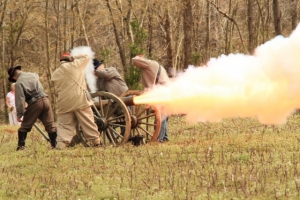Re-enactors show soldiers' life around time of 1862 battle
By Dennis Hill
Published in News on March 29, 2009 2:00 AM

News-Argus/BOBBY WILLIAMS
Tim Seaman, left, Mongo Thornton, Lynn Bull and Bobby Richter, all members of Andrew's Battery, cover their closest to the cannon as they complete a cannon firing demonstration at the Goldsborough Bridge Battlefield.
Civil War re-enactors representing troops who defended Goldsboro against attack in 1862 put on a show for local residents Saturday, re-creating a Confederate encampment and demonstrating rifle and cannon fire on the site of the real battle.
The living history program was sponsored by the Goldsborough Bridge Battlefield Association, a non-profit group that is working to establish and bring recognition to the battle fought on Dec. 17, 1862 and the men who took part in it.
The association is planning a full-scale battle re-creation at the site off Old Mount Highway for December, on the battle's 147th anniversary. Between 400 and 500 re-enactors are expected, said Randy Sauls, the president of the association.
Saturday's program gave members of Andrew's Battery a chance to practice their artillery skills. The unit, fashioned after the actual gunnery unit that included men from Goldsboro, spent most of the war guarding the coastline, at forts Macon and Fisher.
Visitors were able to tour the camp, which included a temporary blacksmith shop operated by Kirt Jarrett, and hear descriptions of the fighting that took place in the woods and fields lining the Neuse River.
When Union invaders advanced on Goldsboro in December, 1862, the inhabitants could not know that Gen. John Foster's goal was to merely destroy the Wilmington & Weldon Railroad bridge south of town, Sauls said. They likely believed Foster's 10,000 men had come to conquer the town itself.
Foster had come from New Bern, hitting Kinston and Whitehall, now Seven Springs, along the way. Kinston had surrendered to the Union troops and Goldsboro residents, knowing their defenders were outnumbered, might well have feared they would come to the same fate.
Following the shootout at Seven Springs, Foster's columns continued west. A day before the battle at Goldsboro, Union cavalry surprised Mount Olive townspeople, tearing up the railroad there and cutting telegraph wires.
The next day, the Union force approached the bridge at Goldsborough, remnants of which can still be seen. Confederate forces were outnumbered 5-to-1 but they kept the blue-coated soldiers at bay until, on a second desperate attempt, a volunteer dashed forward and set the bridge afire.
Considering his mission accomplished, Foster pulled back. The arrival of Confederate reinforcements by rail from Virginia at that moment likely helped him make up his mind. The Southerners even managed to mount a counter-attack but were repulsed with heavy losses.
Sauls said the Goldsbor-ough Bridge Battefield Association, which has erected fences and markers at the battlefield, hopes to have a monument honoring the units that fought there ready by December's re-enactment. It also is working to refurbish an old barn at the site that could be used for various functions.
For more information, visit www.goldsboroughbridge.com or www.andrewsbattery.org.
